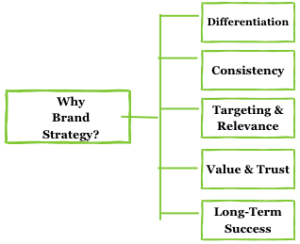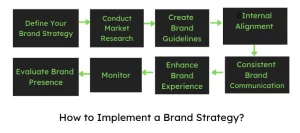The Ultimate Guide to Successful Brand Building Strategies
Businesses need brand building strategies to differentiate themselves from competitors, build customer trust and loyalty, and increase brand recognition and awareness.
Branding Strategy guides marketing efforts, supports business growth, and establishes a consistent and cohesive brand identity, ultimately driving success in the marketplace.
“Your brand is what people say about you when you’re not in the room.” – Jeff Bezos
Let us read in detail what is a brand strategy and why do brands need a strategy.
What is a Brand Strategy?
A brand strategy is a long-term plan that defines how a business intends to position and differentiate its brand in the marketplace. It encompasses the goals, values, target audience, messaging, visual identity, and overall brand experience.

A well-crafted brand strategy guides decision-making and shapes all aspects of a company’s marketing, communication, and customer interactions to build a strong and recognizable brand.
Why do Brands Need a Strategy?
Brands need a strategy for several reasons:

Differentiation:
In a crowded marketplace, a brand strategy helps distinguish a brand from its competitors. It defines unique selling points and creates a distinctive identity that sets the brand apart and attracts customers.
Brand strategy helps create differentiation by:
- Identifying and defining unique selling points (USPs) that set the brand apart from competitors.
- Developing a distinct brand positioning that communicates the brand’s value and relevance to the target audience.
- Crafting a compelling brand story that resonates with customers and creates an emotional connection.
- Establishing a clear and consistent brand voice and tone that differentiates the brand’s communication.
- Designing a unique visual identity, including logos, colours, and typography, that is memorable and distinct.
- Creating a consistent brand experience across all touchpoints, from product packaging to customer service.
- Conducting market research to understand customer needs, preferences, and pain points, enabling the brand to offer tailored solutions.
- Innovating and staying ahead of industry trends, ensuring the brand remains relevant and stands out in the marketplace.
Consistency:
A brand strategy ensures consistency in messaging, visual identity, and customer experience across all touchpoints. Consistency builds trust, fosters brand recognition, and helps customers develop a strong association with the brand.
Having a brand strategy can help businesses maintain consistency as a strategy in place:
- Provide clear brand guidelines and standards that serve as a reference for all brand-related activities.
- Establish a unified brand voice and tone across all communication channels.
- Create a cohesive visual identity with consistent design elements, including logos, colours, fonts, and imagery.
- Ensure consistency in messaging, positioning, and value proposition to reinforce the brand’s identity.
- Guide the development of marketing and advertising campaigns that align with the brand strategy.
- Facilitate consistent brand experiences across various touchpoints, including websites, social media, packaging, and customer interactions.
- Enable effective internal communication and alignment among employees and stakeholders.
- Enhance brand recognition and recall by presenting a consistent and recognizable brand image to the target audience.
- Build trust and reliability among customers through consistent delivery of brand promises.
- Differentiate the brand from competitors by maintaining a consistent and unique brand identity.
Targeting and Relevance:
A brand strategy helps define the target audience and tailor marketing efforts accordingly. It enables brands to understand customer needs, preferences, and aspirations, allowing them to create relevant and meaningful connections with their target market.
When you have a brand strategy to establish a strong foothold in the market, you can have a closer targeting of your audience. It happens because strategically you can do these:
- Conduct market research to identify and understand the target audience’s needs, preferences, and behaviours.
- Define a clear target market and segment the audience based on relevant demographics, psychographics, or other criteria.
- Develop buyer personas that represent the ideal customers and their specific pain points and motivations.
- Tailor brand messaging and communication to resonate with the target audience, addressing their specific needs and aspirations.
- Create products, services, or brand experiences that align with the target audience’s preferences and desires.
- Identify and leverage unique selling points (USPs) that are relevant and appealing to the target audience.
- Craft marketing campaigns and strategies that specifically target the identified audience segments.
- Utilise data and analytics to track and measure the effectiveness of marketing efforts and make data-driven adjustments to optimise targeting and relevance.
- Continuously monitor market trends and consumer insights to stay relevant and adapt the brand strategy accordingly.
- Build relationships and engage with the target audience through personalised and relevant content, experiences, and interactions.
Value and Trust:
A well-executed brand strategy enhances the perceived value of products or services. It establishes trust and credibility with customers, as they associate the brand with quality, reliability, and positive experiences.
When you launch your product and services in the marketplace, as a business you want to increase value and trust for your customers. Because how customers perceive your brand drives the success for you.
A brand strategy helps build value and trust as it assist you to:
- Define and communicate the brand’s unique value proposition and benefits for the customers.
- Establish a consistent brand experience across all touch points.
- Deliver high-quality products to meet customer’s expectations.
- Build reputation for reliability, credibility, and integrity through ethical practices.
- Gain trust by leveraging the power of testimonials, reviews and customer feedback.
- Enhance brand credibility by utilising endorsements.
- Provide exceptional customer service to build long-term relationships with customers.
Long-term Success:
A brand strategy provides a roadmap for long-term success. It sets clear goals, defines the brand’s vision and mission, and outlines the steps needed to achieve them. A strategic approach allows brands to adapt to changing market dynamics, anticipate trends, and stay ahead of the competition.
A brand strategy provides long-term success because with brand-oriented strategic approach you can:
- Establish a clear vision, mission, and set of goals that guide the brand’s direction and growth over time.
- Create a strong and distinctive brand identity that resonates with the target audience and fosters brand recognition.
- Develop a deep understanding of customer needs, preferences, and market dynamics to stay relevant and adapt as necessary.
- Build a loyal customer base through consistent brand experiences, quality products or services, and exceptional customer service.
- Differentiate the brand from competitors by highlighting unique selling points and creating a competitive advantage.
- Continuously monitor market trends, consumer insights, and industry developments to proactively identify opportunities and challenges.
- Adapt and evolve the brand strategy to align with changing market dynamics, consumer preferences, and technological advancements.
- Invest in ongoing brand building activities, such as marketing, advertising, and public relations, to maintain brand visibility and relevance.
- Build strong brand equity, including brand reputation, customer loyalty, and perceived value, which can lead to sustained growth and market leadership.
- Cultivate brand ambassadors and advocates who promote the brand and contribute to its long-term success through positive word-of-mouth and referrals.
Read: What is Strategy Consulting?
How to Build a Successful Branding Marketing Strategy?
Building a successful branding marketing strategy involves several key steps:

Define Your Brand Strategy:
- For a brand, it is better to clearly articulate your brand’s mission, values, and unique selling points.
- To begin with, identify your target audience and understand their needs, preferences, and behaviours.
- And then, develop a brand positioning that sets you apart from competitors.
Conduct Market Research:
- To approach the audience in the right manner and at the right time, you need to have data about your audience. Gather insights about your target market, industry trends, and competitive landscape. It will help you analyse and prepare brand strategies accordingly.
- Identify opportunities and challenges that can inform your brand strategy.
Create Brand Guidelines:
- Establish guidelines for your brand’s visual identity, including logo, colour palette, typography, and imagery.
- Define your brand’s tone of voice, messaging, and communication style. It helps your audience to connect faster with your brand.
- Outline guidelines for brand representation across different channels and touchpoints.
Internal Alignment:
- Ensure internal stakeholders, employees, and team members understand and align with the brand strategy. It confirms that everyone within the organisation understands and works towards the same brand vision, enabling consistent brand representation and a unified customer experience. It fosters a cohesive brand identity.
- Conduct training sessions to educate employees on brand values, messaging, and guidelines.
- Foster a culture that embraces and embodies the brand’s identity and values.
Consistent Brand Communication:
- Implement the brand guidelines across all communication channels, including marketing materials, websites, social media, and advertising campaigns. It ensures a cohesive and consistent brand identity, strengthening brand recognition and creating a unified brand experience for customers.
- Craft consistent and compelling messaging that aligns with your brand’s positioning.
- Regularly review and update communication materials to ensure they reflect the brand strategy.
Brand Experience and Customer Touchpoints:
- Align all customer touchpoints, from physical spaces to digital interactions, with the brand strategy.
- Deliver a consistent brand experience that reflects the brand’s values and resonates with the target audience.
- Pay attention to details, such as packaging, customer service, and user experience, to reinforce the brand identity.
Monitor and Evaluate:
- Continuously track and measure the performance of your brand strategy against defined goals and metrics.
It helps to track performance, identify areas for improvement, and make informed decisions to adapt and optimise the strategy over time, ensuring its relevance and effectiveness in achieving the desired brand objectives.
- Collect feedback from customers, employees, and stakeholders to gain insights and identify areas for improvement.
- Stay updated on market trends and evolving customer preferences to adapt your brand strategy as needed.
Example Of Branding Strategy
Let us read about a native Indian brand with an excellent branding strategy:
Brand: Amul

Branding Strategy:
Let us now dive into the brand strategy that Amul adopted.
- Positioning: Amul positioned itself as “The Taste of India” and focused on promoting its range of dairy products as synonymous with quality, taste, and trust.
- Unique Identity: Amul created a distinctive and recognizable brand identity with its iconic “Amul girl” mascot, which became synonymous with the brand. The Amul girl, with her iconic presence and witty captions, has played a pivotal role in Amul’s branding strategy. She has helped create brand recall, engage with consumers emotionally, and establish Amul as a relatable and socially conscious brand in the dairy industry.
- Emotional Connection: The brand established an emotional connection with consumers through its witty and relatable advertising campaigns, often addressing social and cultural issues.
- Consistent Communication: Amul maintained consistent and creative communication across various mediums, including print, television, social media, and outdoor advertising. The iconic girl by Amul resonated with the audiences and especially its tagline “Utterly Butterly Delicious Amul”
- Quality Assurance: Amul consistently delivered high-quality products, leveraging its cooperative model and state-of-the-art production facilities to ensure freshness and purity.
- Market Expansion: The brand strategically expanded its product portfolio to cater to evolving consumer preferences, introducing new offerings like ice cream, cheese, butter, and other dairy-based products.
- Grassroots Approach: Amul focused on empowering local dairy farmers and involving them in the brand’s growth, fostering a sense of community and sustainability.
The strategic approach helped Amul to align with their cooperative model, ensuring fair and sustainable practices. By uplifting and supporting farmers, Amul strengthened the supply chain, fostered a sense of community, and contributed to the socio-economic development of rural areas, ultimately ensuring a steady and quality milk supply for their dairy products.
Conclusion
Building a brand strategy is a critical step for businesses looking to establish a strong and successful brand. It sets the foundation for differentiation, consistency, relevance, and value creation.
By following the comprehensive steps outlined in this ultimate guide, businesses can develop a strategic approach that aligns with their goals and resonates with their target audience.
We understand that building a brand strategy can be a complex and nuanced process. If you need assistance or guidance in developing your brand strategy, our team of experts is here to help.
Write to us at hello[at]noboruworld.com to embark on your brand-building journey!
FAQ
What is the role of brand strategy in building brand loyalty?
Brand strategy is crucial in building brand loyalty by defining the brand’s values, personality, and unique selling propositions. When consistently communicated and experienced by customers, these elements create an emotional connection, fostering trust and loyalty.
How does brand strategy differ from marketing strategy?
The brand strategy focuses on the long-term development of a brand’s identity, values, and positioning in the market. In contrast, a marketing strategy is more about specific tactics and campaigns to promote products or services. Brand strategy informs and guides marketing efforts.
Why is it important to regularly revisit and evolve a brand strategy?
Markets and consumer preferences change over time. Regularly revisiting and evolving a brand strategy helps ensure that a brand remains relevant and competitive. It allows a brand to adapt to shifts in the industry, technology, and customer expectations, ultimately sustaining its success.
Also Read – Building a brand — a step-by-step guide



